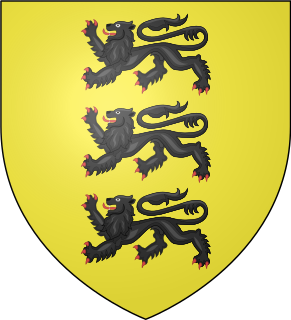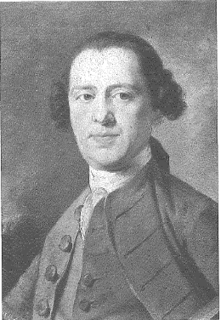
Duke of Atholl, alternatively Duke of Athole, named after Atholl in Scotland, is a title in the Peerage of Scotland held by the head of Clan Murray. It was created by Queen Anne in 1703 for John Murray, 2nd Marquess of Atholl, with a special remainder to the heir male of his father, the 1st Marquess.

Earl of Perth is a title in the Peerage of Scotland. It was created in 1605 for James Drummond, 4th Lord Drummond. The Drummond family claim descent from Maurice, son of George, a younger son of King Andrew I of Hungary. Maurice arrived in Scotland on the ship which brought Edgar Ætheling, the Saxon claimant to the crown of England after the Norman Conquest, and his sister Margaret to Scotland in 1068. Maurice was given lands in Lennox (Dunbartonshire), together with the hereditary stewardship of the county. The Hungarian Prince theory has been discounted as no evidence of any relationships exists in written records or DNA. "The Red Book of the Menteiths" clearly discounts the Hungarian Prince as a myth likely formed to give status to the Drummond origins. The Drummonds in the 12th Century were allied to the Menteiths – their early fortunes developed through the relationship. Indeed, one "Johannes De Drumon", said to have died in 1301, was buried in Inchmahome Priory which was founded by the Menteiths. His successor John Drummond, the 7th Steward, was deprived of the lands and retired into Perthshire.

Earl of Southesk is a title in the Peerage of Scotland. It was created in 1633 for Sir David Carnegie, an Extraordinary Lord of Session. He had already been created Lord Carnegie of Kinnaird in 1616 and was made Lord Carnegie, of Kinnaird and Leuchars, at the same time he was given the earldom. These titles are also in the Peerage of Scotland. The earldom is named after the River South Esk in Angus. Carnegie's younger brother John Carnegie was given the corresponding title: earl of Northesk. The earl of Southesk also holds the Scottish feudal title of Baron of Kinnaird and is a baronet in the Baronetage of Nova Scotia. Kinnaird Castle, Brechin, has been the home of the earls of Southesk for several hundred years.

Earl of Airlie is a title of the peerage in Scotland created on 2 April 1639 for James Ogilvy, 7th Lord Ogilvy of Airlie, along with the title “Lord Ogilvy of Alith and Lintrathen.” The title “Lord Ogilvy of Airlie” was then created on 28 April 1491.

Baron Stafford, referring to the town of Stafford, is a title that has been created several times in the Peerage of England. In the 14th century, the barons of the first creation were made earls. Those of the fifth creation, in the 17th century, became first viscounts and then earls. Since 1913, the title has been held by the Fitzherbert family.

Earl of Derwentwater was a title in the Peerage of England. It was created in 1688 for Sir Francis Radclyffe, 3rd Baronet. He was made Baron Tyndale, of Tyndale in the County of Northumberland, and Viscount Radclyffe and Langley at the same time, also in the Peerage of England. He was succeeded by his son, the second Earl, who married Lady Mary Tudor, daughter of Charles II by his mistress Moll Davis.
Viscount of Kenmure was a title in the Peerage of Scotland. It was created by Charles I in 1633 for the prominent Presbyterian Sir John Gordon, 2nd Baronet. He was made Lord Lochinvar at the same time, also in the Peerage of Scotland. Both titles were created with remainder to "heirs male whatsoever bearing the arms and name of Gordon"
There have been ten baronetcies created for persons with the surname Mackenzie, seven in the Baronetage of Nova Scotia and three in the Baronetage of the United Kingdom. Four of the creations are extant as of 2010.

Fingask Castle is a country house in Perth and Kinross, Scotland. It is perched 200 feet (61 m) above Rait, three miles (5 km) north-east of Errol, in the Braes of the Carse, on the fringes of the Sidlaw Hills. Thus it overlooks both the Carse of Gowrie and the Firth of Tay and beyond into the Kingdom of Fife. The name derives from Gaelic fionn-gasg: a white or light-coloured appendage.
The Wedderburn, later Ogilvy-Wedderburn Baronetcy, of Balindean in the County of Perth, is a title in the Baronetage of the United Kingdom created in 1803.
There have been several Murray Baronetcies, all created in the Baronetage of Nova Scotia. Four of these baronetcies are extant.

There have been three baronetcies created for persons with the surname Carew, two in the Baronetage of England prior to 1707, one in the Baronetage of Great Britain.
There have been three baronetcies created for persons with the surname Foulis, one in the Baronetage of England and two in the Baronetage of Nova Scotia.
There have been four baronetcies created for people with the surname Innes, three in the Baronetage of Nova Scotia and one in the Baronetage of the United Kingdom. Three of the creations are extant as of 2010.
There have been four baronetcies created for persons with the surname Hay, all in the Baronetage of Nova Scotia. Two creations are extinct, one dormant and one extant. A fifth baronetcy in the Jacobite Peerage, although theoretically extant, is not recognised by the Lyon Office.
The Nicolson baronets refer to one of four baronetcies created for persons with the surname Nicolson, all in the Baronetage of Nova Scotia. Two of the creations remain extant as of 2008.
There have been two baronetcies created for members of the Macdonald family, one in the Baronetage of Nova Scotia and one in the Baronetage of the United Kingdom. One creation is extant.

Sir Patrick Threipland, 1st Baronet was a Scottish merchant and politician.
Events from the year 1826 in Scotland.

Stuart Threipland MD, FRCPE was a Scottish physician. He was the son of Sir David Threipland, the second baronet of Fingask and, like his father, was an active Jacobite. After qualifying MD from the University of Edinburgh in 1742 he became a fellow of the Royal College of Physicians of Edinburgh (RCPE) two years later. In 1745 he joined Prince Charles Edward Stuart in the Jacobite rising. He became physician-in-chief to the prince and stayed with the army throughout the campaign. After the Jacobite defeat at Culloden in April 1746 he went into exile in France but was able to return to Scotland under the Act of Indemnity (1747). When his father died in 1746 he succeeded to become de jure the third baronet of Fingask but was technically unable to use the title which had been forfeited by his father because of his support for the Jacobite cause. He practised as a physician in Edinburgh and was elected president of the RCPE in 1766. In 1783 he was able to buy back most of the family estates in Fingask and Kinnaird which had been confiscated from his father in 1715.













